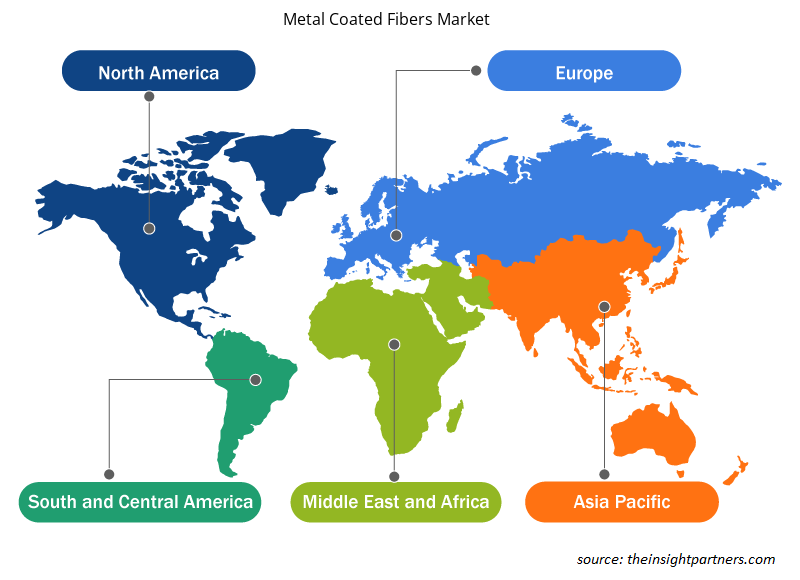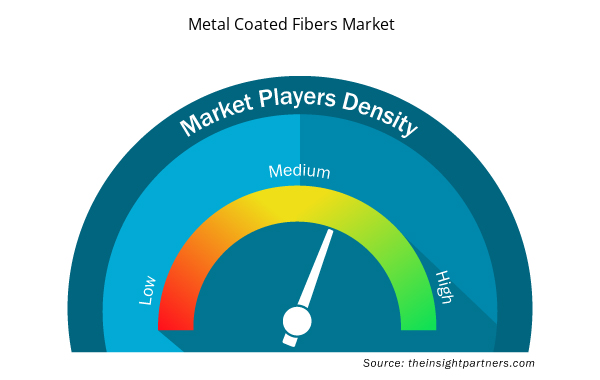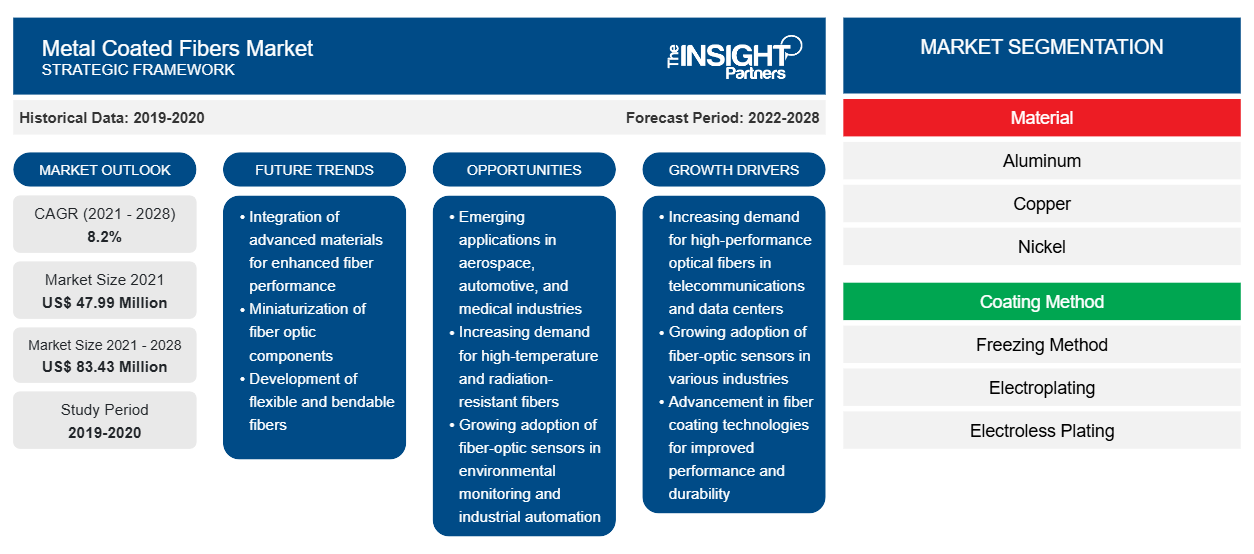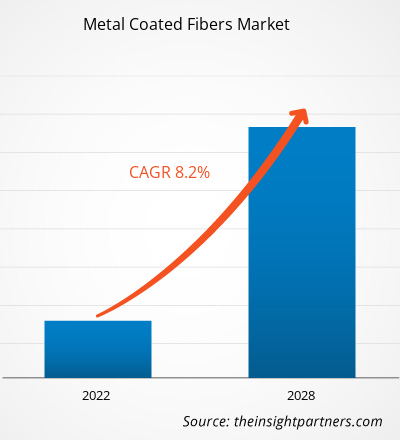Le marché des fibres revêtues de métal était évalué à 47,99 millions de dollars américains en 2021 et devrait atteindre 83,43 millions de dollars américains d'ici 2028 ; il devrait croître à un TCAC de 8,2 % de 2021 à 2028.
Le revêtement joue un rôle important dans la protection de la fibre contre divers dommages tels que la pression et les effets chimiques. La fibre revêtue de métal présente de fortes capacités à satisfaire aux exigences des industries telles que l'aérospatiale, l'industrie chimique et les champs pétrolifères en puits profonds. En Amérique du Nord, les pays émergents connaissent une forte industrialisation, offrant de nombreuses opportunités aux principaux acteurs du marché des fibres revêtues de métal . La croissance massive du marché en Amérique du Nord peut être attribuée aux investissements croissants dans la technologie et aux industries d'utilisateurs finaux à croissance rapide telles que le pétrole et le gaz, l'aérospatiale et la défense et la médecine. Cela a permis à la région de détenir la plus grande part de marché mondiale des fibres revêtues de métal.
Impact de la pandémie de COVID-19 sur le marché des fibres revêtues de métal
La baisse significative de la croissance de plusieurs secteurs industriels en raison de la pandémie de COVID-19 a eu un impact sur la demande de fibres revêtues de métal sur le marché mondial. L'impact de la pandémie de COVID-19 varie selon les différents segments d'application. Par exemple, les activités d'exploration pétrolière et gazière ont considérablement diminué pendant la pandémie. La pandémie a changé l'industrie pétrolière et gazière dans son ensemble, et les acteurs du secteur de l'énergie se sont davantage tournés vers l'adoption des énergies renouvelables.
Personnalisez ce rapport en fonction de vos besoins
Vous bénéficierez d'une personnalisation gratuite de n'importe quel rapport, y compris de certaines parties de ce rapport, d'une analyse au niveau des pays, d'un pack de données Excel, ainsi que de superbes offres et réductions pour les start-ups et les universités.
- Obtenez les principales tendances clés du marché de ce rapport.Cet échantillon GRATUIT comprendra une analyse de données, allant des tendances du marché aux estimations et prévisions.
Informations sur le marché
Besoins croissants des industries de la défense, de l'aérospatiale et de la médecine
Les fibres à revêtement métallique sont utilisées dans l'industrie médicale dans des applications telles que les systèmes de diagnostic plasma dans les réacteurs thermonucléaires et les guides d'images pour l'inspection visuelle des installations nucléaires. Dans l'industrie biomédicale, l'utilisation de la fibre optique s'est rapidement développée, passant de simples guides de lumière et d'images à l'imagerie de nouvelle génération et aux diagnostics avancés. De plus, la croissance et l'expansion continues des industries de la défense, de l'aérospatiale et de la médecine dans divers pays du monde contribuent à la croissance du marché. Ainsi, la forte demande des industries de la défense, de l'aérospatiale et de la médecine stimule la part de marché des fibres à revêtement métallique.
Informations sur les matériaux
En fonction du matériau, les prévisions du marché mondial des fibres revêtues de métal ont été segmentées en aluminium, cuivre, nickel et autres. Le segment de l'aluminium détenait la plus grande part du marché mondial en 2020. Les revêtements en aluminium peuvent être utilisés dans diverses fibres multimodes à indice progressif, à indice progressif et monomodes. Les revêtements en aluminium permettent à la fibre d'être utilisée dans des applications à plage de température plus large. De plus, les fibres revêtues d'aluminium sont utilisées dans les environnements chimiques difficiles, les applications médicales et la détection en fond de trou pour l'industrie pétrolière et gazière.multimode, graded-index, and single-mode fibers. Aluminum coatings enable the fiber to be used on broader temperature range applications. Moreover, aluminum-coated fibers are used in harsh chemical environments, medical applications, and down-hole sensing for the oil & gas industry.
Marché des fibres revêtues de métal, par matériau – 2020 et 2028
Certains des principaux acteurs opérant sur le marché mondial des fibres revêtues de métal sont AFL ; AMS Technologies ; Arts Photonics Gmbh ; Heracle Gmbh ; IVG fiber limited ; Molex LLC ; Forc Photonics ; Thorlabs, Inc. ; OZ Optics ; et Technical Fiber Products.AFL; AMS Technologies; Arts Photonics Gmbh; Heracle Gmbh; IVG fiber limited; Molex LLC; Forc Photonics; Thorlabs, Inc.; OZ Optics; and Technical Fiber Products.
Aperçu régional du marché des fibres revêtues de métal
Les tendances régionales et les facteurs influençant le marché des fibres revêtues de métal tout au long de la période de prévision ont été expliqués en détail par les analystes d’Insight Partners. Cette section traite également des segments et de la géographie du marché des fibres revêtues de métal en Amérique du Nord, en Europe, en Asie-Pacifique, au Moyen-Orient et en Afrique, ainsi qu’en Amérique du Sud et en Amérique centrale.

- Obtenez les données régionales spécifiques au marché des fibres revêtues de métal
Portée du rapport sur le marché des fibres revêtues de métal
| Attribut de rapport | Détails |
|---|---|
| Taille du marché en 2021 | 47,99 millions de dollars américains |
| Taille du marché d'ici 2028 | 83,43 millions de dollars américains |
| Taux de croissance annuel moyen mondial (2021-2028) | 8,2% |
| Données historiques | 2019-2020 |
| Période de prévision | 2022-2028 |
| Segments couverts | Par matériau
|
| Régions et pays couverts | Amérique du Nord
|
| Leaders du marché et profils d'entreprises clés |
|
Densité des acteurs du marché des fibres à revêtement métallique : comprendre son impact sur la dynamique commerciale
Le marché des fibres revêtues de métal connaît une croissance rapide, tirée par la demande croissante des utilisateurs finaux en raison de facteurs tels que l'évolution des préférences des consommateurs, les avancées technologiques et une plus grande sensibilisation aux avantages du produit. À mesure que la demande augmente, les entreprises élargissent leurs offres, innovent pour répondre aux besoins des consommateurs et capitalisent sur les tendances émergentes, ce qui alimente davantage la croissance du marché.
La densité des acteurs du marché fait référence à la répartition des entreprises ou des sociétés opérant sur un marché ou un secteur particulier. Elle indique le nombre de concurrents (acteurs du marché) présents sur un marché donné par rapport à sa taille ou à sa valeur marchande totale.
Les principales entreprises opérant sur le marché des fibres revêtues de métal sont :
- L'AFL
- Technologies AMS
- Art Photonics GmbH
- Technologie des fibres techniques, LLC.
- Industries Fiberguide
Avis de non-responsabilité : les sociétés répertoriées ci-dessus ne sont pas classées dans un ordre particulier.

- Obtenez un aperçu des principaux acteurs du marché des fibres à revêtement métallique
Rapports en vedette
- Tendances progressives de l'industrie sur le marché pour aider les acteurs à développer des stratégies efficaces à long terme
- Stratégies de croissance des entreprises adoptées par les marchés développés et en développement
- Analyse quantitative des prévisions du marché des fibres revêtues de métal de 2019 à 2028
- Estimation de la demande mondiale pour la taille du marché des fibres revêtues de métal
- Analyse des cinq forces de Porter pour illustrer l'efficacité des acheteurs et des fournisseurs opérant dans l'industrie des fibres revêtues de métal
- Développements récents pour comprendre le scénario concurrentiel du marché
- Tendances et perspectives du marché ainsi que facteurs qui stimulent et freinent la croissance du marché
- Aide au processus de prise de décision en mettant en évidence les stratégies de marché qui sous-tendent l'intérêt commercial, conduisant à la croissance du marché des fibres revêtues de métal
- La taille du marché à différents nœuds
- Aperçu détaillé et segmentation du marché, ainsi que la dynamique de l'industrie des fibres revêtues de métal
- Taille du marché des fibres revêtues de métal dans diverses régions avec des opportunités de croissance prometteuses
Le marché mondial des fibres revêtues de métal est segmenté par matériau en aluminium, cuivre, nickel et autres. En fonction de la méthode de revêtement, le marché mondial est segmenté en méthode de congélation, galvanoplastie, placage autocatalytique et autres. En fonction de l'utilisation finale, le marché mondial est segmenté en pétrole et gaz, défense et aérospatiale, médecine, télécommunications et centres de données, recherche et développement, etc.
Profils d'entreprise
- L'AFL
- Technologies AMS
- ARTS PHOTONICS GMBH
- Heracle GMBH
- IVG fibre limitée
- Molex SARL
- Composants électro-optiques, Inc.
- Thorlabs, Inc.
- Optique OZ
- Produits en fibres techniques
- Analyse historique (2 ans), année de base, prévision (7 ans) avec TCAC
- Analyse PEST et SWO
- Taille du marché Valeur / Volume - Mondial, Régional, Pays
- Industrie et paysage concurrentiel
- Ensemble de données Excel


- Hydrogen Storage Alloys Market
- Clear Aligners Market
- Airport Runway FOD Detection Systems Market
- Enzymatic DNA Synthesis Market
- Semiconductor Metrology and Inspection Market
- Battery Testing Equipment Market
- Adaptive Traffic Control System Market
- Power Bank Market
- Truck Refrigeration Market
- Educational Furniture Market

Report Coverage
Revenue forecast, Company Analysis, Industry landscape, Growth factors, and Trends

Segment Covered
This text is related
to segments covered.

Regional Scope
North America, Europe, Asia Pacific, Middle East & Africa, South & Central America

Country Scope
This text is related
to country scope.
Questions fréquemment posées
The medical segment is the fastest growing segment in the global metal coated fibers market during the forecasted period. In the medical industry, metal coated fibers are used in applications such as plasma diagnostic systems in thermonuclear reactors and image guides for visual inspection of nuclear installations
The freezing method segment held the largest share of the market in 2021. The freezing method is one of the most widely used coating method. This freezing method provides fiber strength twice as high as that of polymer-coated fibers.
The copper segment is the fastest growing segment in the global metal coated fibers market during the forecasted period. Copper is one of the most used fiber coating materials. They are used in various applications such as high-temperature environments, the oil & gas industry, medical applications, etc.
The aluminum segment held the largest share of the global metal coated fibers market in 2021. Aluminum coatings enable the fiber to be used on broader temperature range applications. Aluminum-coated fibers are used in harsh chemical environments, medical applications, and down-hole sensing for the oil & gas industry.
The major players operating in the global metal coated fibers market are AFL; AMS Technologies; Arts Photonics Gmbh; Heracle Gmbh; IVG fiber limited; Molex LLC; Forc Photonics; Thorlabs, Inc.; OZ Optics; Technical Fiber Products; among others.
In 2021, North America held the largest share of the global metal coated fibers market. The massive growth of the market in the North America region is due to the presence of manufacturing units of major industries such as oil & gas and aerospace.
Trends and growth analysis reports related to Chemicals and Materials : READ MORE..
The List of Companies
1. AFL
2. AMS Technologies
3. Art Photonics GmbH
4. Engineered Fibers Technology, LLC.
5. Fiberguide Industries
6. Heracle GmbH
7. Hollingsworth and Vose
8. IVG Fiber
9. OZ Optics Ltd
10. TECHNICAL FIBRE PRODUCTS
The Insight Partners performs research in 4 major stages: Data Collection & Secondary Research, Primary Research, Data Analysis and Data Triangulation & Final Review.
- Data Collection and Secondary Research:
As a market research and consulting firm operating from a decade, we have published and advised several client across the globe. First step for any study will start with an assessment of currently available data and insights from existing reports. Further, historical and current market information is collected from Investor Presentations, Annual Reports, SEC Filings, etc., and other information related to company’s performance and market positioning are gathered from Paid Databases (Factiva, Hoovers, and Reuters) and various other publications available in public domain.
Several associations trade associates, technical forums, institutes, societies and organization are accessed to gain technical as well as market related insights through their publications such as research papers, blogs and press releases related to the studies are referred to get cues about the market. Further, white papers, journals, magazines, and other news articles published in last 3 years are scrutinized and analyzed to understand the current market trends.
- Primary Research:
The primarily interview analysis comprise of data obtained from industry participants interview and answers to survey questions gathered by in-house primary team.
For primary research, interviews are conducted with industry experts/CEOs/Marketing Managers/VPs/Subject Matter Experts from both demand and supply side to get a 360-degree view of the market. The primary team conducts several interviews based on the complexity of the markets to understand the various market trends and dynamics which makes research more credible and precise.
A typical research interview fulfils the following functions:
- Provides first-hand information on the market size, market trends, growth trends, competitive landscape, and outlook
- Validates and strengthens in-house secondary research findings
- Develops the analysis team’s expertise and market understanding
Primary research involves email interactions and telephone interviews for each market, category, segment, and sub-segment across geographies. The participants who typically take part in such a process include, but are not limited to:
- Industry participants: VPs, business development managers, market intelligence managers and national sales managers
- Outside experts: Valuation experts, research analysts and key opinion leaders specializing in the electronics and semiconductor industry.
Below is the breakup of our primary respondents by company, designation, and region:

Once we receive the confirmation from primary research sources or primary respondents, we finalize the base year market estimation and forecast the data as per the macroeconomic and microeconomic factors assessed during data collection.
- Data Analysis:
Once data is validated through both secondary as well as primary respondents, we finalize the market estimations by hypothesis formulation and factor analysis at regional and country level.
- Macro-Economic Factor Analysis:
We analyse macroeconomic indicators such the gross domestic product (GDP), increase in the demand for goods and services across industries, technological advancement, regional economic growth, governmental policies, the influence of COVID-19, PEST analysis, and other aspects. This analysis aids in setting benchmarks for various nations/regions and approximating market splits. Additionally, the general trend of the aforementioned components aid in determining the market's development possibilities.
- Country Level Data:
Various factors that are especially aligned to the country are taken into account to determine the market size for a certain area and country, including the presence of vendors, such as headquarters and offices, the country's GDP, demand patterns, and industry growth. To comprehend the market dynamics for the nation, a number of growth variables, inhibitors, application areas, and current market trends are researched. The aforementioned elements aid in determining the country's overall market's growth potential.
- Company Profile:
The “Table of Contents” is formulated by listing and analyzing more than 25 - 30 companies operating in the market ecosystem across geographies. However, we profile only 10 companies as a standard practice in our syndicate reports. These 10 companies comprise leading, emerging, and regional players. Nonetheless, our analysis is not restricted to the 10 listed companies, we also analyze other companies present in the market to develop a holistic view and understand the prevailing trends. The “Company Profiles” section in the report covers key facts, business description, products & services, financial information, SWOT analysis, and key developments. The financial information presented is extracted from the annual reports and official documents of the publicly listed companies. Upon collecting the information for the sections of respective companies, we verify them via various primary sources and then compile the data in respective company profiles. The company level information helps us in deriving the base number as well as in forecasting the market size.
- Developing Base Number:
Aggregation of sales statistics (2020-2022) and macro-economic factor, and other secondary and primary research insights are utilized to arrive at base number and related market shares for 2022. The data gaps are identified in this step and relevant market data is analyzed, collected from paid primary interviews or databases. On finalizing the base year market size, forecasts are developed on the basis of macro-economic, industry and market growth factors and company level analysis.
- Data Triangulation and Final Review:
The market findings and base year market size calculations are validated from supply as well as demand side. Demand side validations are based on macro-economic factor analysis and benchmarks for respective regions and countries. In case of supply side validations, revenues of major companies are estimated (in case not available) based on industry benchmark, approximate number of employees, product portfolio, and primary interviews revenues are gathered. Further revenue from target product/service segment is assessed to avoid overshooting of market statistics. In case of heavy deviations between supply and demand side values, all thes steps are repeated to achieve synchronization.
We follow an iterative model, wherein we share our research findings with Subject Matter Experts (SME’s) and Key Opinion Leaders (KOLs) until consensus view of the market is not formulated – this model negates any drastic deviation in the opinions of experts. Only validated and universally acceptable research findings are quoted in our reports.
We have important check points that we use to validate our research findings – which we call – data triangulation, where we validate the information, we generate from secondary sources with primary interviews and then we re-validate with our internal data bases and Subject matter experts. This comprehensive model enables us to deliver high quality, reliable data in shortest possible time.


 Obtenez un échantillon gratuit pour ce rapport
Obtenez un échantillon gratuit pour ce rapport